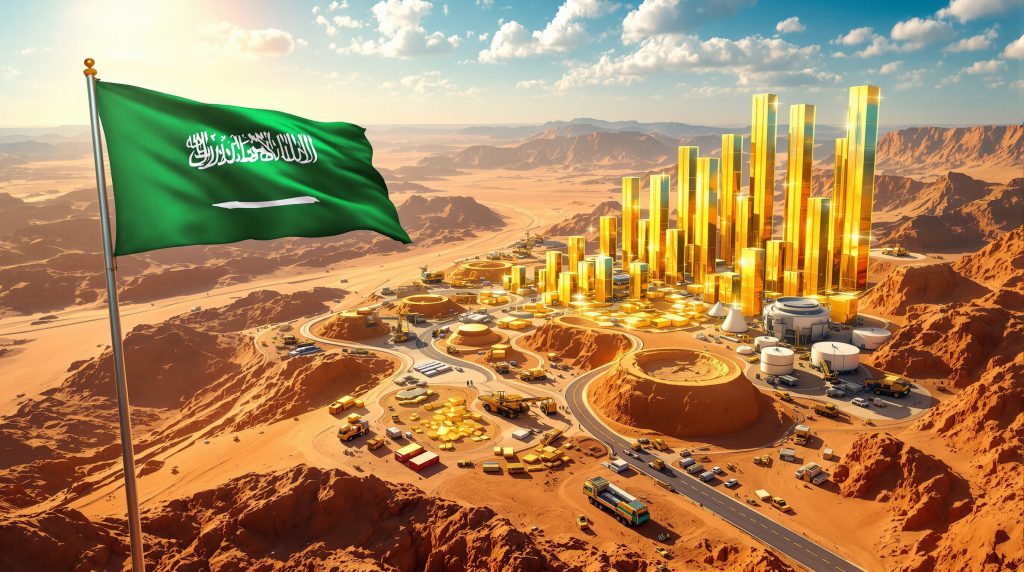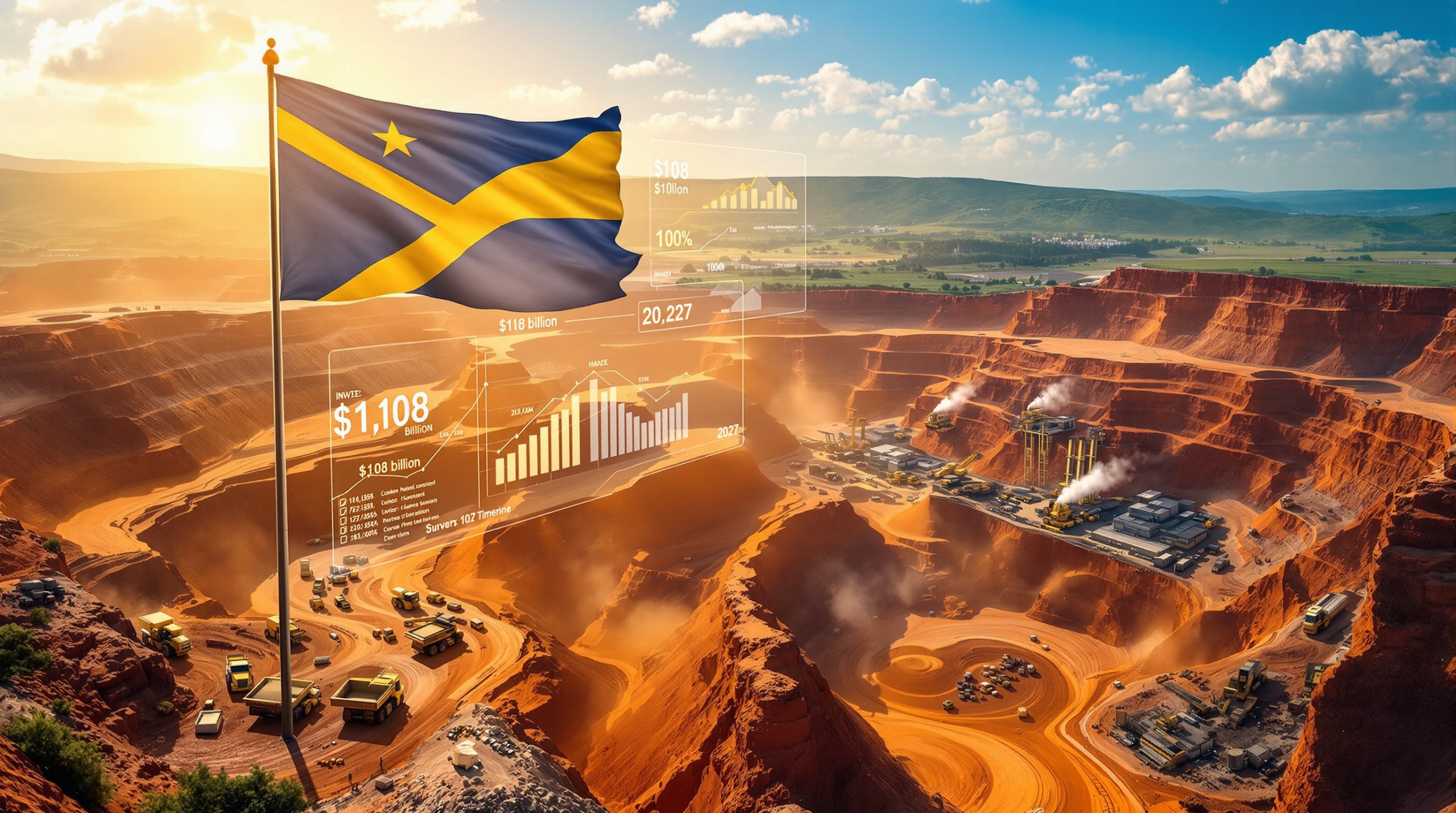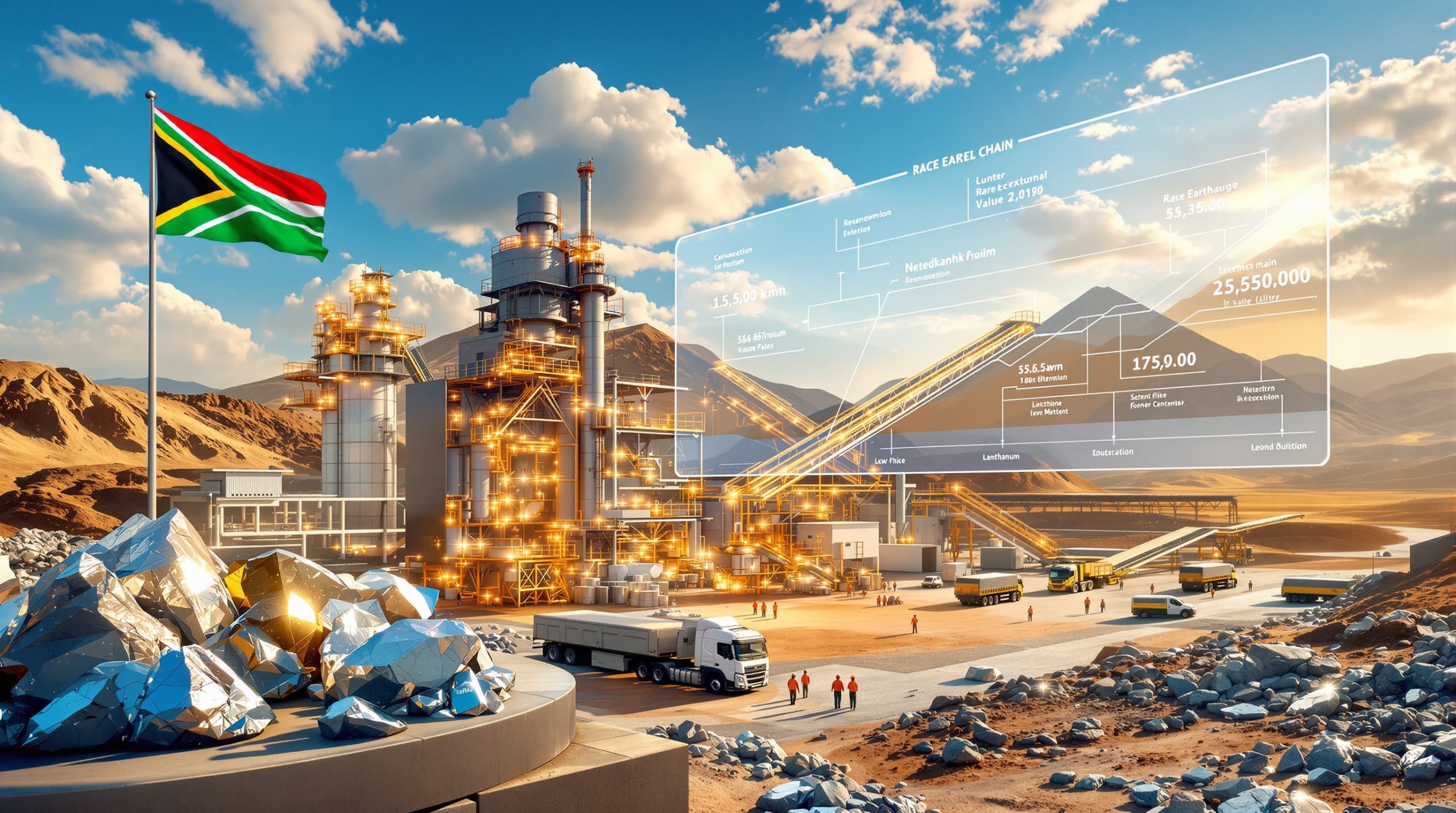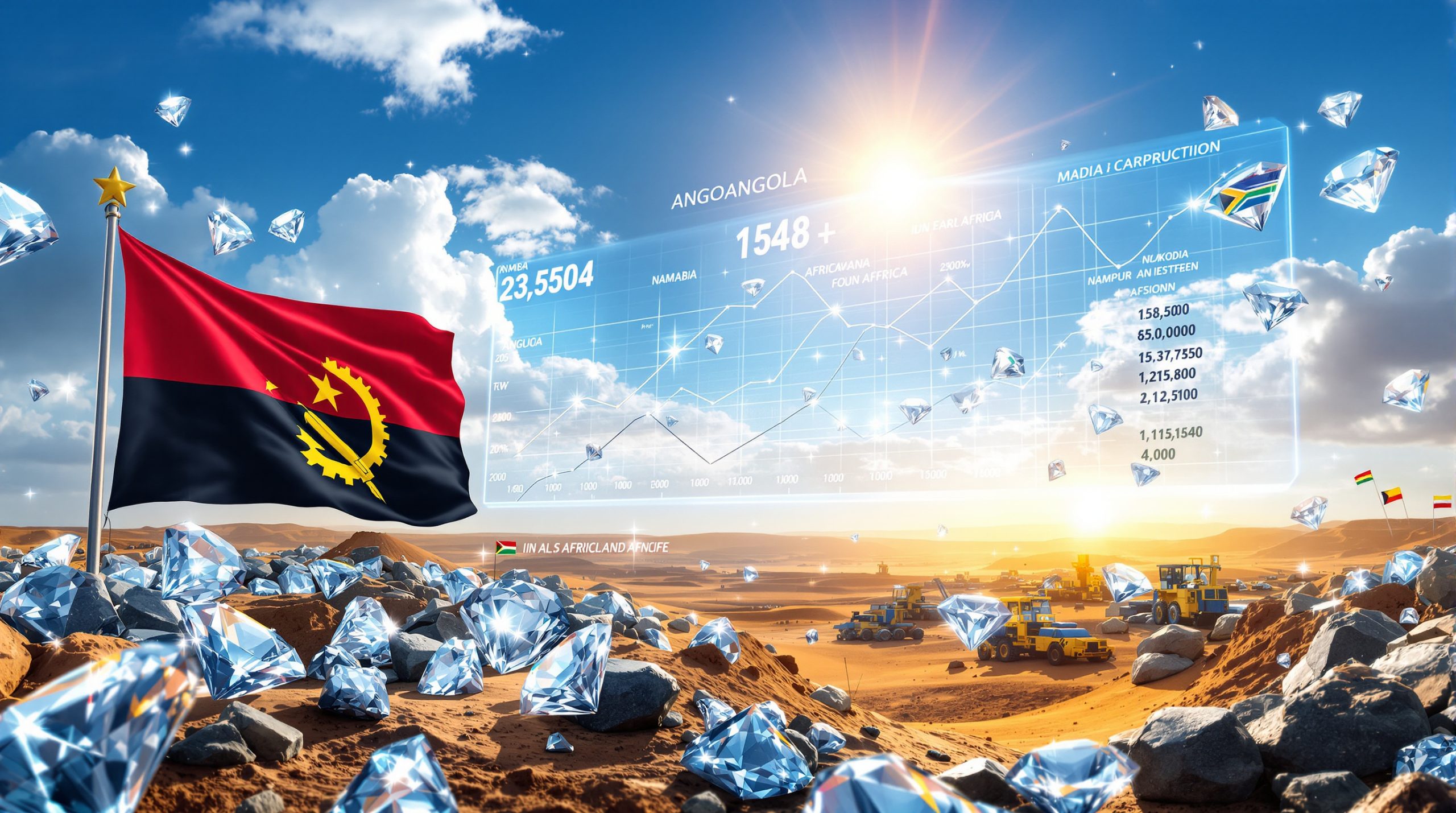Saudi Arabia's Strategic Shift Toward Mineral Wealth
The Kingdom of Saudi Arabia has embarked on an unprecedented transformation of its mineral exploration landscape, marking a pivotal shift in its economic diversification strategy. Saudi mining exploration investment has emerged as a cornerstone of the nation's Vision 2030, representing far more than simple policy adjustments; it signals a fundamental reimagining of the Kingdom's resource-based economy beyond petroleum dependency.
Mining now serves as the designated third pillar of Saudi Arabia's Vision 2030, complementing oil and gas in the nation's economic framework. The geological wealth beneath Saudi soil extends far beyond hydrocarbons, encompassing substantial deposits of gold, copper, zinc, phosphate, and rare earth elements distributed across the Arabian Shield and surrounding geological formations.
Current geological assessments suggest the Kingdom possesses mineral resources valued at approximately $1.3 trillion, representing one of the world's most significant untapped mining opportunities. The Arabian Shield alone covers roughly 630,000 square kilometers, containing Precambrian rock formations that harbour diverse metallic and industrial mineral deposits.
Quantifying the Investment Surge in Saudi Mining Exploration
The transformation of Saudi mining exploration spending represents one of the most dramatic sectoral investment increases in recent economic history. Exploration expenditures have surged by 500% since 2020, escalating from relatively modest baseline levels to substantial multi-billion-dollar commitments that rival established mining jurisdictions globally.
Government investment has led this expansion, with the Saudi Public Investment Fund allocating over SAR 20 billion ($5.3 billion) specifically for mineral sector development through 2030. Furthermore, Saudi exploration licenses have facilitated unprecedented growth in private sector participation, with foreign direct investment in exploration activities increasing from approximately $200 million in 2020 to over $1.2 billion in 2024.
Investment Distribution Analysis
| Investment Source | 2020 Baseline | 2024 Current | Growth Rate |
|---|---|---|---|
| Government Funding | $180M | $950M | 428% |
| Foreign Investment | $200M | $1.2B | 500% |
| Domestic Private | $95M | $580M | 511% |
| Joint Ventures | $45M | $340M | 656% |
The licensing framework has simultaneously expanded to accommodate increased interest, with over 1,400 exploration licenses currently active across the Kingdom. This represents a 300% increase from the 450 licenses active in 2020, demonstrating the scale of international and domestic exploration activity.
Regional investment patterns reveal concentrated activity in the Arabian Shield region, which accounts for approximately 65% of total exploration spending. Northern provinces, particularly those containing porphyry copper systems, attract 25% of investment, while industrial mineral projects in central regions command the remaining allocation.
Regulatory Framework Revolution Driving Investment Growth
The Saudi government has implemented comprehensive regulatory reforms designed to accelerate Saudi mining exploration investment and streamline operational procedures. These changes address historical barriers that previously limited foreign participation and complicated project development timelines.
100% foreign ownership is now permitted in mining ventures, eliminating previous partnership requirements that deterred international investment. This policy adjustment represents a fundamental shift from historical approaches that mandated local partnerships for foreign mining companies.
Streamlined Licensing Procedures
The Ministry of Industry and Mineral Resources has reduced exploration licence approval timelines from 18-24 months to 4-6 months, implementing digital processing systems and standardised evaluation criteria. Technical requirements have been simplified while maintaining geological and environmental standards.
Risk mitigation programmes now provide government co-funding for exploration activities up to SAR 7.5 million ($2 million) per project, with additional technical support through the Saudi Geological Survey. These programmes particularly target early-stage exploration in frontier areas where geological data remains limited.
Key Regulatory Improvements:
- Simplified environmental impact assessment procedures for exploration activities
- Standardised royalty rates ranging from 5% to 7% depending on commodity type
- Fast-track processing for projects exceeding $50 million investment thresholds
- Guaranteed processing facility development rights for successful exploration ventures
- Tax incentives including accelerated depreciation and reduced corporate rates during initial production phases
Saudi Arabia's Diverse Mineral Resource Portfolio
The Kingdom's geological diversity encompasses metallic and industrial minerals distributed across distinct geological provinces, each offering unique investment opportunities and development challenges. Understanding this resource distribution provides crucial context for mineral exploration importance and investment strategies.
Arabian Shield Gold Potential
Gold exploration represents the most active segment of Saudi mining exploration investment, concentrated within the Arabian Shield's greenstone belt systems. Over 5,000 historical gold workings have been identified across the shield, indicating extensive mineralisation that supports modern exploration efforts.
Current gold resources exceed 10 million ounces in measured and indicated categories, with exploration programmes targeting additional 20-30 million ounces in inferred resources. In addition, recent gold price analysis indicates favourable market conditions that support the economic viability of these projects. The Mahd adh Dhahab deposit remains the Kingdom's flagship gold operation, producing approximately 150,000 ounces annually while serving as a model for regional development.
Base Metal Opportunities
Copper mineralisation within porphyry and volcanogenic massive sulfide systems presents substantial development potential, particularly in northern regions near the Jordanian border. Jabal Sayid copper-gold deposit contains approximately 61 million tonnes of measured resources grading 1.02% copper equivalent.
Mineral Resource Distribution:
| Commodity | Estimated Resources | Primary Locations | Development Stage |
|---|---|---|---|
| Gold | 10M+ oz (M&I) | Arabian Shield | Advanced exploration |
| Copper | 850,000 tonnes metal | Northern provinces | Early development |
| Zinc | 2.1M tonnes metal | Scattered deposits | Exploration |
| Phosphate | 1.4B tonnes | Northern/Central | Production ready |
| Industrial minerals | Extensive | Multiple provinces | Various stages |
Zinc-lead mineralisation occurs within sediment-hosted and skarn-type deposits, with the Al Amar deposit containing approximately 14.5 million tonnes grading 2.4% zinc and 0.8% lead. These resources support potential regional smelting and refining operations.
Government Investment Acceleration Programmes
Saudi Arabia's mining development strategy extends beyond regulatory improvements to encompass comprehensive financial and technical support systems designed to accelerate project development and reduce investment risks for private sector participants.
The Saudi Mining Development Company (Ma'aden) serves as both operator and investment vehicle, with allocated capital exceeding $15 billion for mineral sector expansion through 2030. Ma'aden partnerships provide technical expertise and risk sharing for international exploration companies entering the Saudi market.
Financial Support Mechanisms
National Industrial Development Center (NIDC) offers exploration grants covering up to 75% of qualified exploration costs for projects meeting specific criteria. Grant funding caps at SAR 7.5 million per project, with additional performance bonuses available for successful resource definition.
The Saudi Development Fund provides low-interest financing for mining infrastructure projects, including processing facilities, transportation networks, and utility systems. Interest rates range from 2-4% depending on project scale and strategic importance.
"Government co-funding programmes have supported over 200 exploration projects since 2020, contributing approximately SAR 1.2 billion in direct financial assistance whilst leveraging additional private investment exceeding SAR 4 billion." according to Trade Arabia's analysis of Saudi mining developments.
Technical Assistance Programmes
The Saudi Geological Survey provides comprehensive geological databases, including airborne geophysical surveys, geochemical sampling results, and regional geological mapping at 1:250,000 scale coverage. This information significantly reduces early-stage exploration costs and risks for private companies.
Upcoming Licensing Opportunities:
- Q2 2025: Northern copper province tender covering 15,000 square kilometres
- Q3 2025: Arabian Shield gold exploration areas encompassing 25,000 square kilometres
- Q4 2025: Industrial minerals licensing round for phosphate and industrial sand deposits
- 2026: Rare earth element exploration permits in southern shield regions
Global Mining Investment Competitiveness Analysis
Saudi Arabia's emergence as a preferred mining investment destination reflects both improved regulatory frameworks and inherent geological advantages that distinguish the Kingdom from traditional mining jurisdictions worldwide.
The Fraser Institute Annual Survey of Mining Companies now ranks Saudi Arabia among the top 25% globally for investment attractiveness, representing a dramatic improvement from previous decades when regulatory uncertainty limited international participation.
Competitive Investment Advantages
Geographic positioning provides Saudi mining operations with preferential access to Asian processing markets, particularly China and India, which consume over 60% of global mineral production. Transportation costs to major Asian ports average $15-25 per tonne less than equivalent shipments from African or South American mining regions.
Energy costs represent a significant competitive advantage, with industrial electricity rates approximately 40% below average costs in established mining jurisdictions such as Australia, Canada, or Chile. Natural gas availability supports energy-intensive processing operations at globally competitive rates.
Infrastructure Investment Commitments:
- $12 billion allocated for mining-specific transportation networks through 2030
- New ports development at Ras Al Khair and Yanbu specifically designed for bulk mineral exports
- Processing zones established in Riyadh, Jeddah, and Dammam with dedicated mineral processing facilities
- Workforce development programmes targeting 50,000 new mining sector jobs by 2030
Regional Market Access Benefits
Saudi Arabia's membership in the Gulf Cooperation Council and various trade agreements provides preferential access to regional markets consuming industrial minerals, processed metals, and specialised mining products. The Kingdom's strategic location enables cost-effective distribution throughout the Middle East, Africa, and Asia.
Port infrastructure investments specifically target mining exports, with Ras Al Khair Industrial Port designed to handle 25 million tonnes annually of bulk mineral products. This capacity exceeds current production requirements whilst supporting future expansion plans.
Investment Challenges and Risk Assessment Framework
Despite substantial opportunities and government support, Saudi mining exploration investment involves specific challenges that require careful evaluation and risk management strategies for successful project development.
Climate considerations significantly impact operational planning, with summer temperatures exceeding 45°C in many mineral-rich regions. These conditions necessitate specialised equipment, increased cooling costs, and modified work schedules that affect overall project economics.
Water availability represents a critical constraint for mining operations, particularly for processing activities requiring substantial water consumption. Desalination costs range from $0.80-1.20 per cubic metre, adding operational expenses that must be incorporated into feasibility studies.
Technical and Operational Risk Factors
Workforce development remains challenging despite government training programmes, with skilled mining professionals commanding premium salaries due to regional scarcity. International companies typically employ 30-50% expatriate workforce during initial development phases.
Environmental compliance requires adherence to increasingly stringent standards, particularly regarding groundwater protection and habitat preservation. Environmental impact assessments must address desert ecosystem preservation and potential impacts on archaeological sites.
Operational Risk Management:
- Currency hedging strategies to manage SAR/USD exchange rate fluctuations
- Supply chain diversification to reduce dependence on single-source equipment and materials
- Security protocols for remote exploration and mining operations
- Local content requirements mandating progressive increases in Saudi workforce participation
- Technology transfer agreements as conditions for large-scale mining licences
Market Dynamics and Commodity Price Considerations
Global mineral demand projections support Saudi mining development, with particular strength in industrial minerals, rare earth elements, and battery metals essential for renewable energy technologies. However, the broader mining industry evolution influences market dynamics significantly. Copper demand is projected to increase 70% by 2030, driven primarily by electrification and renewable energy infrastructure.
Gold price stability above $1,800 per ounce supports economic viability for Saudi gold projects, with production costs typically ranging from $900-1,200 per ounce depending on deposit characteristics and processing requirements.
Future Development Projections and Strategic Outlook
Saudi Arabia's mining sector transformation trajectory suggests continued acceleration through 2030, with investment levels potentially reaching $25-30 billion in total exploration and development expenditure over the next five years.
Production target projections indicate potential output of 300,000 ounces of gold annually by 2030, representing a doubling of current production levels. Copper production could reach 150,000 tonnes annually once porphyry deposits enter production phases.
Technology Integration and Innovation Initiatives
Digital exploration technologies including artificial intelligence, machine learning, and advanced geophysical processing are being integrated into Saudi exploration programmes. The government has allocated SAR 500 million for mining technology development and digital infrastructure supporting remote operations.
Furthermore, AI in mining operations is revolutionising efficiency and safety standards across the sector. NEOM serves as a testing ground for autonomous mining equipment and digital processing systems, with partnerships involving major international technology providers developing next-generation mining solutions suitable for challenging desert environments.
Innovation Programme Highlights:
- Autonomous drilling systems reducing exploration costs by 25-30%
- Real-time ore grade monitoring using advanced sensor technologies
- Predictive maintenance programmes minimising equipment downtime in remote locations
- Renewable energy integration targeting 50% renewable power for mining operations by 2030
- Carbon capture technologies for processing operations with high energy requirements
Regional Hub Development Strategy
The Kingdom's strategic vision encompasses development as a regional mining and processing hub, leveraging geographic advantages and infrastructure investments to serve broader Middle Eastern and African markets.
Processing capacity expansion targets 5 million tonnes annually of mineral processing by 2030, including copper smelting, gold refining, and industrial mineral processing. These facilities will serve both domestic production and imported concentrates from regional producers.
Value-added manufacturing integration creates opportunities for downstream industries including aluminium products, steel manufacturing, and specialised alloys supporting regional construction and infrastructure development.
Strategic Investment Considerations for Market Participants
Saudi Arabia's mining transformation presents compelling opportunities for international investors, exploration companies, and mining service providers seeking exposure to one of the world's most rapidly developing mineral sectors.
Entry timing considerations suggest optimal investment windows during 2025-2027, when regulatory frameworks remain favourable whilst competition for premium exploration areas intensifies. Early market participants benefit from preferential licensing terms and government support programmes.
Partnership strategies with established Saudi companies or Ma'aden provide local expertise, regulatory navigation, and risk sharing whilst satisfying government preferences for technology transfer and local capacity building.
Critical Success Factors
Technical expertise in desert exploration and mining operations represents essential capabilities for successful Saudi ventures. Companies with experience in similar geological and climatic conditions demonstrate higher success rates in project development.
Financial capacity requirements typically exceed traditional exploration budgets due to infrastructure development needs and extended development timelines in remote locations. Successful projects generally require $50-100 million in total investment for significant operations.
Long-term Economic Impact and Regional Development
The mining sector's contribution to Saudi GDP diversification extends beyond direct production value to encompass job creation, infrastructure development, and industrial capacity building that supports broader economic transformation objectives.
Employment generation projections indicate 50,000 direct mining jobs by 2030, with additional 100,000 indirect positions in supporting services, transportation, and processing activities. These employment opportunities particularly benefit remote regions with limited economic alternatives.
Regional development initiatives linked to mining projects include new cities, educational institutions, and healthcare facilities serving mining communities whilst supporting broader population distribution goals outlined in Vision 2030.
The transformation of Saudi Arabia's mining exploration landscape represents more than sectoral development; it embodies the Kingdom's strategic evolution toward economic diversification and global mineral market participation. According to analysis by Arabian Business, the Kingdom's exploration spending surge demonstrates sustained commitment to this transformation. Investment opportunities continue expanding as regulatory improvements, infrastructure development, and international partnerships accelerate the sector's maturation into a cornerstone of post-oil economic prosperity.
Looking to Capitalise on Mineral Discovery Opportunities?
Discovery Alert's proprietary Discovery IQ model delivers instant notifications on significant ASX mineral discoveries, enabling subscribers to identify actionable opportunities ahead of the broader market. Understand why historic discoveries can generate substantial returns by exploring examples of exceptional mining outcomes, then begin your 30-day free trial to position yourself ahead of the market.




